Asparagus growers should consider scouting their fields during the summer months for foliar disease development. Important pathogens that growers need to scout for on a regular basis include Purple spot, Cercospora, and Rust. [Read more…]
Vegetable Crops Edition
Seasonal updates and alerts on insects, diseases, and weeds impacting vegetable crops. New Jersey Commercial Vegetable Production Recommendations updates between annual publication issues are included.
Subscriptions are available via EMAIL and RSS.
Quick Links:
 NJ Commercial Vegetable Production Recommendations
NJ Commercial Vegetable Production Recommendations
 Rutgers Weather Forecasting - Meteorological Information important to commercial agriculture.
Rutgers Weather Forecasting - Meteorological Information important to commercial agriculture.
PHI for Select and Poast herbicides in peppers
The 1 day pre-harvest intervals (PHI) listed for Select 2EC, Select Max, and Poast herbicides in the pepper section of the 2019 Mid Atlantic Commercial Vegetable Production Recommendations is false.
The actual PHI as found on the most recent labels of these herbicides are as follows:
- Select 2EC: 20 days
- Select Max 0.97EC: 20 days
- Poast 1.5 EC: 7 days
Errors will be addressed in the 2020 updated version of the guide.
Vegetable IPM Update 7/31/19
Sweet Corn
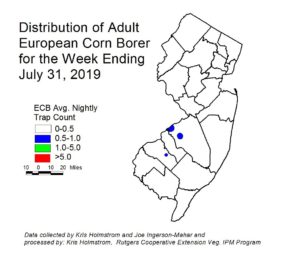 European corn borer (ECB) moth captures have increased slightly in parts of the southern half of the state (see ECB map at left). Thus far, the second flight appears to be very weak, as is consistent with recent years’ second flights. Limited feeding has appeared in whorl and pre-tassel corn.
European corn borer (ECB) moth captures have increased slightly in parts of the southern half of the state (see ECB map at left). Thus far, the second flight appears to be very weak, as is consistent with recent years’ second flights. Limited feeding has appeared in whorl and pre-tassel corn.
Growers should continue to scout whorl and pre-tassel stage plantings weekly and consider treating when infested plants exceed 12% in a 50 plant sample. As plantings proceed to the pre-tassel stage, ECB larvae may be found in emerging tassels. It is a good idea to treat individual plantings as they move into the full tassel/first silk stage one time. This eliminates any ECB larvae that have emerged with the tassels as they begin to move down the stalk to re-enter near developing ears.
Useful insecticides for this particular application include synthetic pyrethroids (IRAC Grp 3), spinosyns (including OMRI approved Entrust) IRAC Grp 5), and diamides such as Coragen (IRAC Grp 28) or materials such as Besiege which include the active ingredient in Coragen. Synthetic pyrethroids alone should NOT be used for corn earworm (CEW) protection on silking corn. Control with these materials is very inconsistent.
The highest nightly black light trap catches of ECB for the week ending 7/31/19 are as follows:
| Chester 1 | Hillsborough 1 | Sergeantsville 1 |
| Cinnaminson 1 | Medford 1 | Sparta 1 |
| Downer 1 | Milltown 1 | Tabernacle 1 |
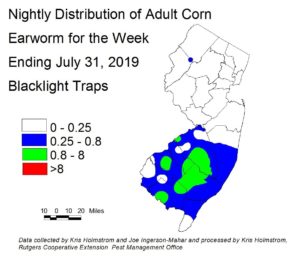 Corn earworm (CEW) moth catches have increased somewhat in blacklight traps in the southern half of the state, while pheromone traps have remained fairly steady with the exception of Cape May County, where a significant increase occurred (see blacklight map at left, and pheromone trap map below at right). Some coastal trap catches from states to our south are showing signs of increase, but overall, catches remain highly variable. While none of these catches indicate that a large scale migratory influx is underway, the trend has been gradual increase with scattered hot-spots. Red areas on the on the pheromone trap map indicate a 3-day silk spray schedule, while green
Corn earworm (CEW) moth catches have increased somewhat in blacklight traps in the southern half of the state, while pheromone traps have remained fairly steady with the exception of Cape May County, where a significant increase occurred (see blacklight map at left, and pheromone trap map below at right). Some coastal trap catches from states to our south are showing signs of increase, but overall, catches remain highly variable. While none of these catches indicate that a large scale migratory influx is underway, the trend has been gradual increase with scattered hot-spots. Red areas on the on the pheromone trap map indicate a 3-day silk spray schedule, while green 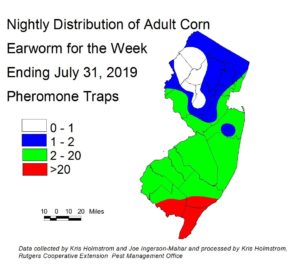 indicates a 4-5 day silk spray schedule. Blue areas represent a 5-6 day schedule, and white areas are 6-7 day. There are far fewer CEW pheromone traps than blacklights, and the resulting map has much broader color bands as a result. It should also be noted that the pheromone traps are much more sensitive than blacklights. Therefore, the number of moths caught in pheromone traps required to generate a specific spray interval is much higher than the number caught in blacklight traps. It must be stressed that there is high variability in these catches, and growers should consult with their IPM practitioner on recommended spray schedules.
indicates a 4-5 day silk spray schedule. Blue areas represent a 5-6 day schedule, and white areas are 6-7 day. There are far fewer CEW pheromone traps than blacklights, and the resulting map has much broader color bands as a result. It should also be noted that the pheromone traps are much more sensitive than blacklights. Therefore, the number of moths caught in pheromone traps required to generate a specific spray interval is much higher than the number caught in blacklight traps. It must be stressed that there is high variability in these catches, and growers should consult with their IPM practitioner on recommended spray schedules.
Imported Fresh Basil Cyclospora Outbreak
A multistate Cyclospora outbreak linked to fresh imported basil was announced by the FDA late yesterday. For more information on the outbreak visit the FDA outbreak webpage. The New Jersey Department of Agriculture is closely monitoring the situation and will be communicating the latest updates.
Vegetable IPM Update 7/24/19
Sweet Corn
European corn borer (ECB) moth captures have again declined to extremely low numbers, and no map will appear in this edition. Thus far, the second flight appears to be very weak, as is consistent with recent years’ second flights. Limited feeding should appear within 1-2 weeks, but may be obscured by fall armyworm (FAW) feeding by that time.
Growers should continue to scout whorl and pre-tassel stage plantings weekly and consider treating when infested plants exceed 12% in a 50 plant sample. As plantings proceed to the pre-tassel stage, ECB larvae may be found in emerging tassels. It is a good idea to treat individual plantings as they move into the full tassel/first silk stage one time. This eliminates any ECB larvae that have emerged with the tassels as they begin to move down the stalk to re-enter near developing ears.
Useful insecticides for this particular application include synthetic pyrethroids (IRAC Grp 3), spinosyns (including OMRI approved Entrust) IRAC Grp 5), and diamides such as Coragen (IRAC Grp 28) or materials such as Besiege which include the active ingredient in Coragen. Synthetic pyrethroids alone should NOT be used for corn earworm (CEW) protection on silking corn. Control with these materials is very inconsistent.
The highest nightly black light trap catches of ECB for the week ending 7/24/19 are as follows:
| Denville 2 | Old Bridge 1 |
| Dayton 1 | |
| Eldora 1 | |
| Long Valley 1 |
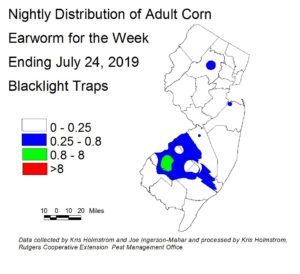 Corn earworm (CEW) moth catches have remained fairly steady (but highly variable) in blacklight traps, while pheromone traps have registered significant increases in some areas over the past week (see blacklight map at left, and pheromone trap map below at right). Catches from North Carolina remain highly variable, while Delaware’s catches are similar to our southern NJ catches while also exhibiting wide variability. While none of these catches indicate that a large scale migratory influx is underway, the trend has been gradual increase with scattered hot-spots. Red areas on the on the pheromone trap map indicate a 3-day silk spray schedule, while green indicates a 4-5 day silk spray
Corn earworm (CEW) moth catches have remained fairly steady (but highly variable) in blacklight traps, while pheromone traps have registered significant increases in some areas over the past week (see blacklight map at left, and pheromone trap map below at right). Catches from North Carolina remain highly variable, while Delaware’s catches are similar to our southern NJ catches while also exhibiting wide variability. While none of these catches indicate that a large scale migratory influx is underway, the trend has been gradual increase with scattered hot-spots. Red areas on the on the pheromone trap map indicate a 3-day silk spray schedule, while green indicates a 4-5 day silk spray 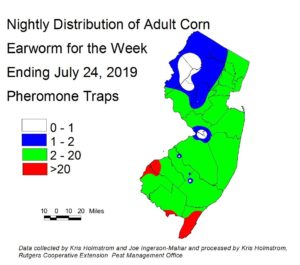 schedule. Blue areas represent a 5-6 day schedule, and white areas are 6-7 day. There are far fewer CEW pheromone traps than blacklights, and the resulting map has much broader color bands as a result. It should also be noted that the pheromone traps are much more sensitive than blacklights. Therefore, the number of moths caught in pheromone traps required to generate a specific spray interval is much higher than the number caught in blacklight traps. It must be stressed that there is high variability in these catches, and growers should consult with their IPM practitioner on recommended spray schedules.
schedule. Blue areas represent a 5-6 day schedule, and white areas are 6-7 day. There are far fewer CEW pheromone traps than blacklights, and the resulting map has much broader color bands as a result. It should also be noted that the pheromone traps are much more sensitive than blacklights. Therefore, the number of moths caught in pheromone traps required to generate a specific spray interval is much higher than the number caught in blacklight traps. It must be stressed that there is high variability in these catches, and growers should consult with their IPM practitioner on recommended spray schedules.
Cucurbit Downy Mildew Alert – 7/19/19
Cucurbit downy mildew has been reported on winter squash near Glassboro in southern New Jersey (Gloucester County). This is the third report of CDM this growing season in the state. All cucurbit growers are encouraged to scout fields on a daily basis and begin preventative fungicide programs if already not initiated.
